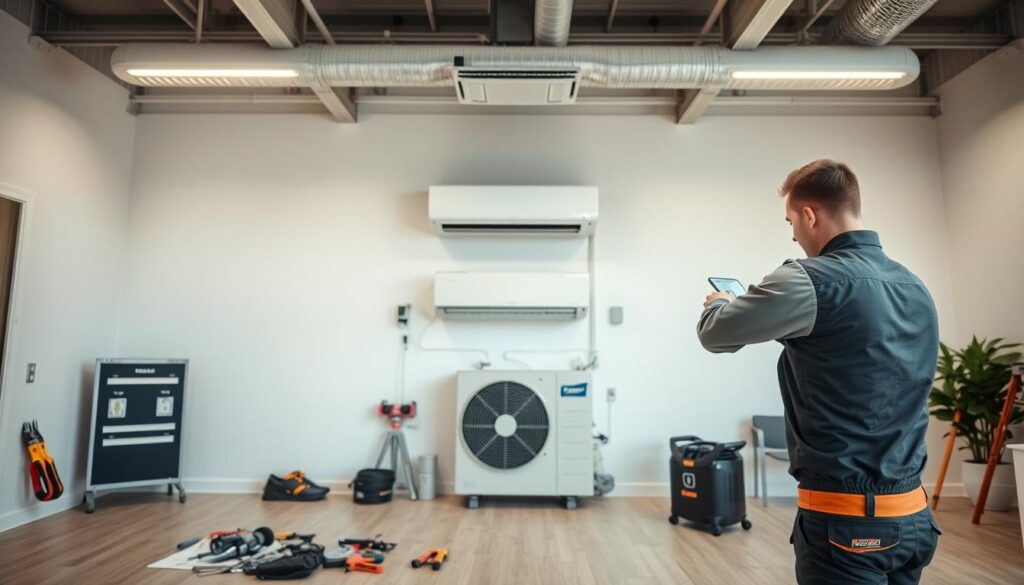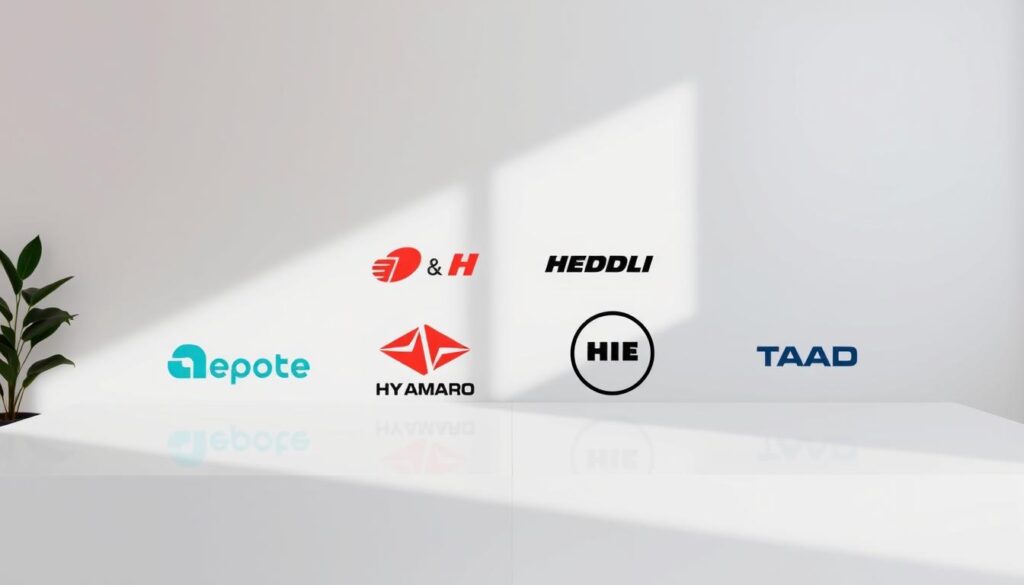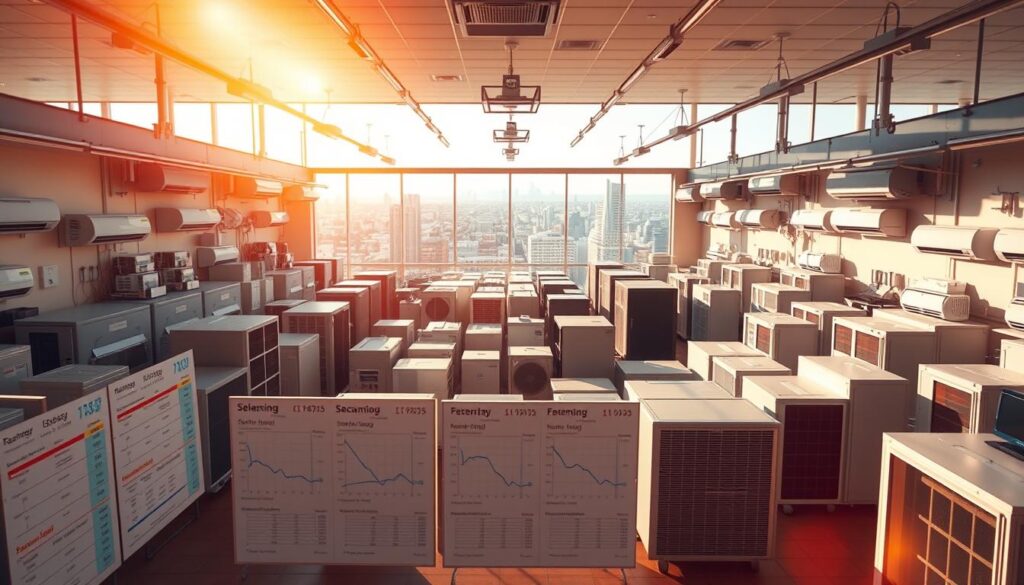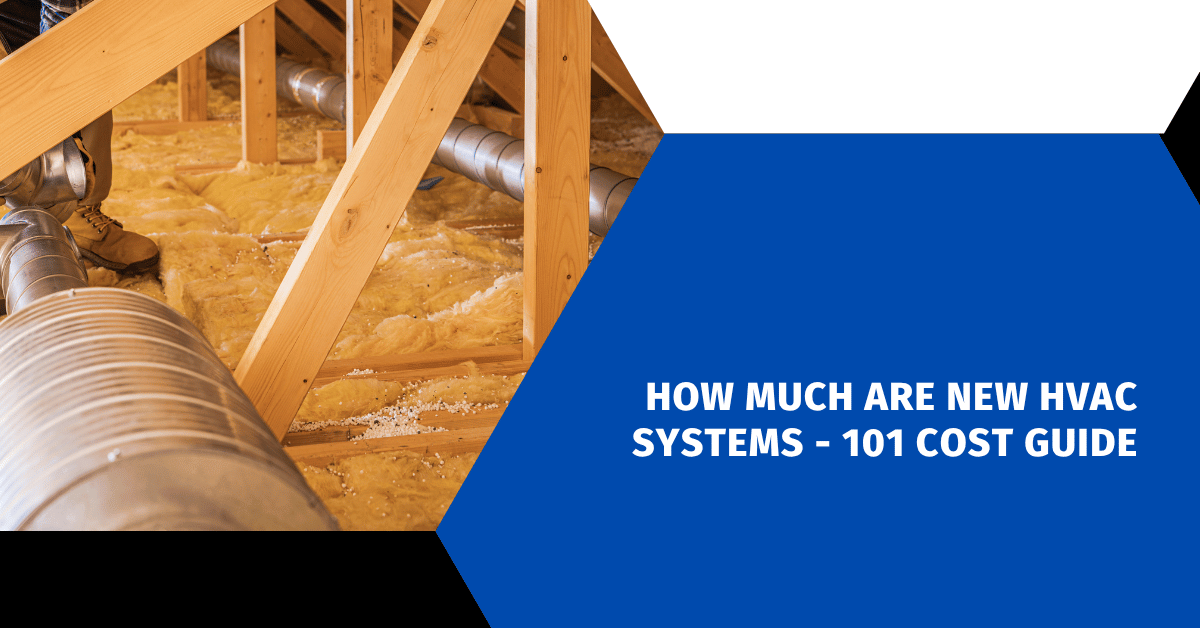Affiliate Disclosure
HVAC Guide Guys is a participant in the Amazon Services LLC Associates Program, an affiliate advertising program designed to provide a means for sites to earn advertising fees by advertising and linking to Amazon.
How Much Are New HVAC Systems? Are you ready to find out how much a new HVAC system costs in 2024? Getting a new HVAC can seem like a big financial challenge. But, knowing the cost doesn’t have to be hard.

For homeowners, the cost of installing a new HVAC system is key. On average, you might spend between $5,000 and $12,500 for a new system in 2024. Most people end up paying around $7,500.
This guide will cover all you need to know about HVAC system prices. We’ll help you choose the right system for your home’s comfort without breaking the bank. We’ll talk about different systems and what affects the cost of installation.
Key Takeaways
- Average HVAC system replacement costs range from $5,000 to $12,500
- Prices vary based on home size, system type, and installation complexity
- Energy efficiency can significantly impact long-term costs
- Professional installation is key for the best system performance
- Financing options are available to help with upfront costs
Table of Contents
Understanding HVAC System Replacement Costs in 2024
Replacing your HVAC system is a big deal that needs careful planning. In 2024, knowing about hvac replacement prices is key for homeowners. The cost of a new HVAC unit varies based on type, size, and how hard it is to install.
When looking at hvac unit prices, several costs come into play. Let’s look at the main expenses that will affect your total cost:
Basic Cost Ranges for Different Systems
- Central Air Conditioner: $4,000 – $8,000
- Gas Furnace: $4,000 – $6,000
- Heat Pump Systems: $5,000 – $10,000
Labor and Installation Expenses
Installation costs can really add up. HVAC pros charge $50 to $100 per hour. The complexity of your job will decide your labor costs.
| System Type | Average Labor Cost | Installation Time |
|---|---|---|
| Central Air Conditioner | $1,500 – $2,500 | 1-2 days |
| Furnace | $1,000 – $2,000 | 1 day |
| Heat Pump | $2,000 – $3,500 | 2-3 days |
Additional Equipment Costs
You might also need to budget for extra equipment:
- Ductwork modifications
- Thermostat upgrades
- Electrical system adjustments
“Proper planning and understanding of hvac replacement prices can help you make an informed decision and potentially save thousands of dollars.”
Investing in a good HVAC system can save you money in the long run. It also makes your home more comfortable.
Explore Our HVAC Shop
Looking for top-rated HVAC tools, parts, and accessories? Visit our shop and find the perfect solution for your needs.
Visit the ShopFactors That Influence HVAC Installation Pricing
Knowing what affects furnace and ac replacement costs helps you plan better. Several important factors determine the price of your HVAC installation.
Your home’s features greatly affect the cost. Consider these:
- Home Size and Layout: Bigger homes need more powerful, expensive HVAC systems
- Existing Infrastructure: Your current ductwork and electrical systems can change installation complexity
- Regional Climate: Harsh weather requires stronger heating and cooling systems
Energy efficiency ratings are key. High-efficiency units cost more upfront but save money over time by using less energy.
Seasonal demand also matters. Prices might go up in summer and winter due to more service needs. Contractors often charge more during these times.
Your location affects prices too. Urban areas have higher labor costs than rural areas, impacting costs.
Pro tip: Always get multiple quotes and consider the total cost of ownership, not just the initial installation price.
Understanding these factors helps you make better HVAC choices. This can lead to long-term savings.
How Much Are New HVAC Systems Based on Home Size
Choosing the right HVAC system depends on your home’s size. The size of your home affects the type and cost of new HVAC system quotes. This helps homeowners find affordable HVAC solutions that meet their needs.
When planning your HVAC installation, consider these key factors related to home size:
- Precise system capacity matching your square footage
- Energy efficiency requirements
- Potential long-term cost savings
Small Home Systems (1,000-1,500 sq ft)
For compact homes, you’ll need a 1.5 to 2-ton unit. These smaller systems are budget-friendly, costing between $3,500 to $5,500. They use less energy, which means lower costs.
Medium Home Systems (1,500-2,500 sq ft)
Medium-sized homes require 2.5 to 3.5-ton units. Affordable HVAC solutions for these spaces cost between $4,500 and $7,500. These systems balance performance and energy efficiency.
Large Home Systems (2,500+ sq ft)
Larger homes need 4 to 5-ton units, costing $6,500 to $12,000. These systems ensure comfort but are a big investment.
Pro tip: Always consult with a professional HVAC technician to get the most accurate system sizing for your specific home.
Explore Our HVAC Shop
Looking for top-rated HVAC tools, parts, and accessories? Visit our shop and find the perfect solution for your needs.
Visit the ShopTypes of HVAC Systems and Their Price Points
Choosing the right HVAC system is key to your home’s comfort. Different systems vary in cost and performance. It’s important to know your options.
Let’s look at the most popular HVAC systems:
- Central Air Conditioning with Gas Furnace
- Entry-Level: $6,000 – $8,000
- Mid-Range: $8,000 – $12,000
- Premium: $12,000 – $16,000+
- Heat Pump Systems
- Standard Split System: $7,500 – $14,000
- High-Efficiency Models: $10,000 – $18,000
- Ductless Mini-Split Systems
- Single Zone: $3,500 – $5,500
- Multi-Zone: $6,000 – $12,000
“Your HVAC installation costs depend on the system’s complexity and efficiency rating.”
Each system has its own benefits. Central systems offer full heating and cooling. Heat pumps are energy-efficient. Mini-splits are great for controlling temperature in specific areas.
When choosing energy-efficient HVAC options, think about long-term savings. A high-efficiency system can lower your monthly bills and make your home more comfortable.
Energy Efficiency Ratings and Cost Impact
It’s important to understand energy efficiency ratings when choosing HVAC options. These ratings affect both the cost of the unit and your energy bills over time. Modern homeowners should think about the system’s long-term performance, not just the initial cost.
Efficiency ratings show how much energy your HVAC system uses and how much you can save. Two main metrics help you decide:
SEER Ratings: Cooling System Efficiency
SEER (Seasonal Energy Efficiency Ratio) shows how efficient a cooling system is. Here’s what you need to know:
- Minimum SEER rating of 14 required in Northern states
- Southeast and South require a minimum 15 SEER rating
- Higher SEER ratings mean better energy use
AFUE Ratings: Heating System Performance
AFUE (Annual Fuel Utilization Efficiency) measures heating system efficiency:
- Mid-efficiency systems: 80-83% AFUE
- High-efficiency heating systems: 90-98.5% AFUE
- Higher percentages mean more heat per fuel unit
Long-term Savings
High-efficiency HVAC systems might cost more at first but save you money on energy bills. A system with higher SEER and AFUE ratings can save you hundreds of dollars annually.
Pro tip: Calculate energy savings by comparing different efficiency ratings before buying.
Brand Comparison and Price Variations

When looking at hvac replacement prices, knowing about brand differences can save you a lot. Not all HVAC brands are the same. Choosing the right one affects both the upfront cost and how well it works over time.
Top HVAC brands offer different affordable hvac solutions. They have different prices and features. You should pick one that fits your budget, quality needs, and reliability expectations.
- Carrier: Premium pricing with excellent reliability
- Lennox: High-efficiency systems with advanced technology
- Trane: Durable units with robust warranties
- Rheem: Budget-friendly options with solid performance
Premium brands cost between $5,000 and $10,000. Mid-tier options are $3,500 to $7,000. Budget brands might be under $3,000. But, they might need more repairs, which could cost more in the long run.
When comparing HVAC brands, consider these important factors:
- Warranty coverage
- Energy efficiency ratings
- Installation complexity
- Customer support reputation
Pro tip: Always research manufacturer reviews and get multiple quotes. This way, you can find the best value for your home needs.
Explore Our HVAC Shop
Looking for top-rated HVAC tools, parts, and accessories? Visit our shop and find the perfect solution for your needs.
Visit the ShopInstallation Complexity and Additional Costs
When planning a new HVAC system, homeowners must think about more than just the initial cost. The installation costs can rise due to complex factors that often surprise people. Knowing these extra costs helps you budget better for your new HVAC system quotes.
Several key elements can increase the installation costs beyond the equipment price:
Ductwork Modifications
Old ductwork might need big changes to fit a new HVAC system. These changes can be anything from small fixes to full replacements:
- Minor duct repairs: $300 – $600
- Full ductwork replacement: $2,000 – $6,000
- Sealing and insulation improvements
- Adjustments for new system compatibility
Electrical Requirements
Most modern HVAC systems need special electrical setups. Your home might need electrical upgrades for the new system:
- Electrical panel upgrades: $500 – $2,000
- New circuit installations: $200 – $500
- Wiring changes
- Voltage checks
Permit and Inspection Fees
Local rules often require permits and inspections for HVAC installs. These costs vary by area but are key for safety and compliance:
- Permit fees: $50 – $500
- Professional inspection costs
- Potential follow-up needs
Pro tip: Always talk to a licensed HVAC pro for exact estimates for your needs.
Seasonal Pricing and Timing Your Purchase
Knowing when to buy new HVAC systems can save you money. The right time to install can greatly affect costs.

Homeowners who plan ahead save a lot. The best times to buy are in fall and spring. These seasons have lower prices.
- Fall (September-November): Ideal for air conditioning system replacements
- Spring (March-May): Perfect for heating system installations
- Winter and summer: Peak demand periods with higher prices
By choosing the right time, you can save 10-20% on costs. This is because manufacturers and contractors offer big discounts during these times.
| Season | Price Range | Availability |
|---|---|---|
| Fall | Low to Moderate | High contractor availability |
| Spring | Low to Moderate | Flexible scheduling |
| Summer | High | Limited availability |
| Winter | High | Limited availability |
Plan your HVAC replacement in fall or spring. This way, you save money and get a smoother installation.
Financing Options and Payment Plans
Getting a new HVAC system can cost a lot for homeowners. But, there are many hvac financing plans to help with the cost. These options make upgrading your home’s comfort easier on your wallet.
There are several ways to pay for your HVAC installation:
- Manufacturer Financing Programs
- Low introductory interest rates
- Flexible repayment terms
- Often tied to specific brands or models
- Home Improvement Loans
- Unsecured personal loans
- Competitive interest rates
- Quick approval process
- Energy Efficiency Mortgages
- Special loans for energy-saving upgrades
- Potential tax incentives
- Long-term cost savings
When looking at hvac financing plans, think about your finances. Some programs offer zero-percent introductory rates, and others have longer payment terms. You can find affordable options from credit unions, banks, and HVAC financing companies.
Before picking a financing option, compare:
- Interest rates
- Repayment terms
- Qualification requirements
- Potential penalties
Remember, a good HVAC system can save you money in the long run. This could help pay off your initial financing costs.
Explore Our HVAC Shop
Looking for top-rated HVAC tools, parts, and accessories? Visit our shop and find the perfect solution for your needs.
Visit the ShopWays to Maximize Your HVAC Investment
Buying an HVAC system is more than just the initial cost. Smart homeowners know it’s about making smart choices and planning for the future. This includes picking energy-efficient options and thinking long-term.
Here are some ways to get the most out of your HVAC investment:
- Choose high-efficiency systems with excellent SEER ratings
- Invest in professional installation to ensure optimal performance
- Sign up for regular maintenance plans
- Select systems with complete warranty coverage
The real cost of an HVAC system is more than just the price tag. Energy-efficient models might cost more upfront but save you money on bills. A high SEER rating can cut your energy costs by hundreds each year.
| Investment Strategy | Potential Annual Savings |
|---|---|
| High-efficiency HVAC system | $300-$600 |
| Regular maintenance | $100-$250 |
| Smart thermostat integration | $130-$180 |
Your HVAC system is a big investment in your home’s comfort and value. By choosing energy-efficient options and focusing on long-term performance, you’ll enjoy a more comfortable home. Plus, you’ll protect your investment.
Conclusion
Getting a new HVAC system is a big choice for homeowners. Knowing the cost of new HVAC systems helps you choose wisely. It’s about finding a balance between upfront costs and long-term benefits like comfort and energy savings.
The cost of installing an HVAC system changes based on several things. These include your home’s size, the type of system, and your local climate. You want a system that works well and saves money over time. Look at energy efficiency ratings and the savings they offer.
When you’re ready to upgrade your HVAC, do your homework and get quotes from experts. Don’t just look at the initial cost. Think about energy savings, maintenance, and how long the system will last. A smart HVAC investment means comfort, savings, and peace of mind for years.
Every home is different, and what fits one might not fit another. Talking to a professional HVAC technician can give you advice that fits your home perfectly. They can help you make the best choice for your heating and cooling needs.

